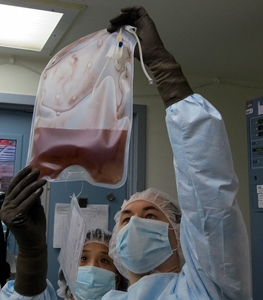6 March 2014. Researchers from University of Pennsylvania, Albert Einstein College of Medicine, and the biotechnology company Sangamo BioSciences showed the company’s gene-editing technology could engineer the immune cells of HIV-positive patients to resist infection and decrease their viral loads. Results of the early-stage clinical trial led by Penn immunologist Carl June will be presented at this week’s Conference on Retroviruses and Opportunistic Infections in Boston and appears today in the New England Journal of Medicine (paid subscription required).
The trial tested the safety and potential efficacy of engineered T-cells, white blood cells in the immune system that defend against invading viruses, among 12 HIV-positive patients. The T-cells were taken from the patients themselves, then altered by blocking actions of the CCR5 gene, whose proteins enable the reception of HIV viruses. Removing the gene’s impact, in effect, simulates a mutation that creates a natural resistance to HIV infection.
The altering of the T-cell genomes used Sangamo BioSciences’ techniques for editing CCR5 genes the company code-names SB-728-T. The company’s platform creates zinc finger nucleases, enzymes that make it possible to modify DNA sequences. The modifications can include corrections and insertions into those sequences, or in this case, disruption of the sequence.
In this trial, some 10 billion T-cells were returned to the patients, with 11 to 28 percent of the cells genetically-altered with SB-728-T. The study looked primarily for safety issues, such as adverse reactions to the therapy, but also measured rebuilding of the patients’ immune systems and resistance to HIV. Six of the 12 patients also interrupted their antiretroviral therapy for up to 12 weeks, about a month after the infusion of T-cells.
The results following the first infusion showed a large spike in modified T-cells after one week. The number of those cells in the patients’ blood declined over several weeks, but decreases in the modified cells were less than those of unmodified T-cells during the interruption of antiretrovirals. The researchers also found modified T-cells in gut-associated lymphoid tissue, considered an important reservoir of immune cells and HIV infection, which indicates the modified T-cells function and move normally in the body.
June and colleagues also measured viral loads of patients in the trial that show amounts of HIV virus RNA in a blood sample. Four of the six patients who interrupted their antiretroviral treatments saw their viral loads decrease, in one case below standard detection levels, although that patient had an inherited genetic composition that favored the altered CCR5 gene.
The researchers say the SB-728-T infusions were safe and well-tolerated. They report one adverse effect, which they attribute to a reaction to the transfusion. The team plans further clinical trials to test larger infusions of T-cells and with larger numbers of patients.
Read more:
- Community Pharmacies Found Helpful in Encouraging HIV Tests
- Algorithm Identifies HIV Antibodies For Vaccine Design
- NIH Stops HIV Vaccine Immunizations in Clinical Trial
- Generic HIV Drugs Save Money, But Could Impair Effectiveness
* * *


 RSS - Posts
RSS - Posts
You must be logged in to post a comment.